Business Environment Case Study on Nestle
VerifiedAdded on 2020/02/17
|16
|5193
|199
Case Study
AI Summary
This case study analyzes the business environment of Nestle, focusing on its organizational purposes, stakeholder management, and the impact of economic policies. It evaluates how Nestle navigates market structures, competition policies, and global factors that shape its operations. The report emphasizes the importance of stakeholder engagement and the role of international trade in enhancing business potential despite economic challenges.
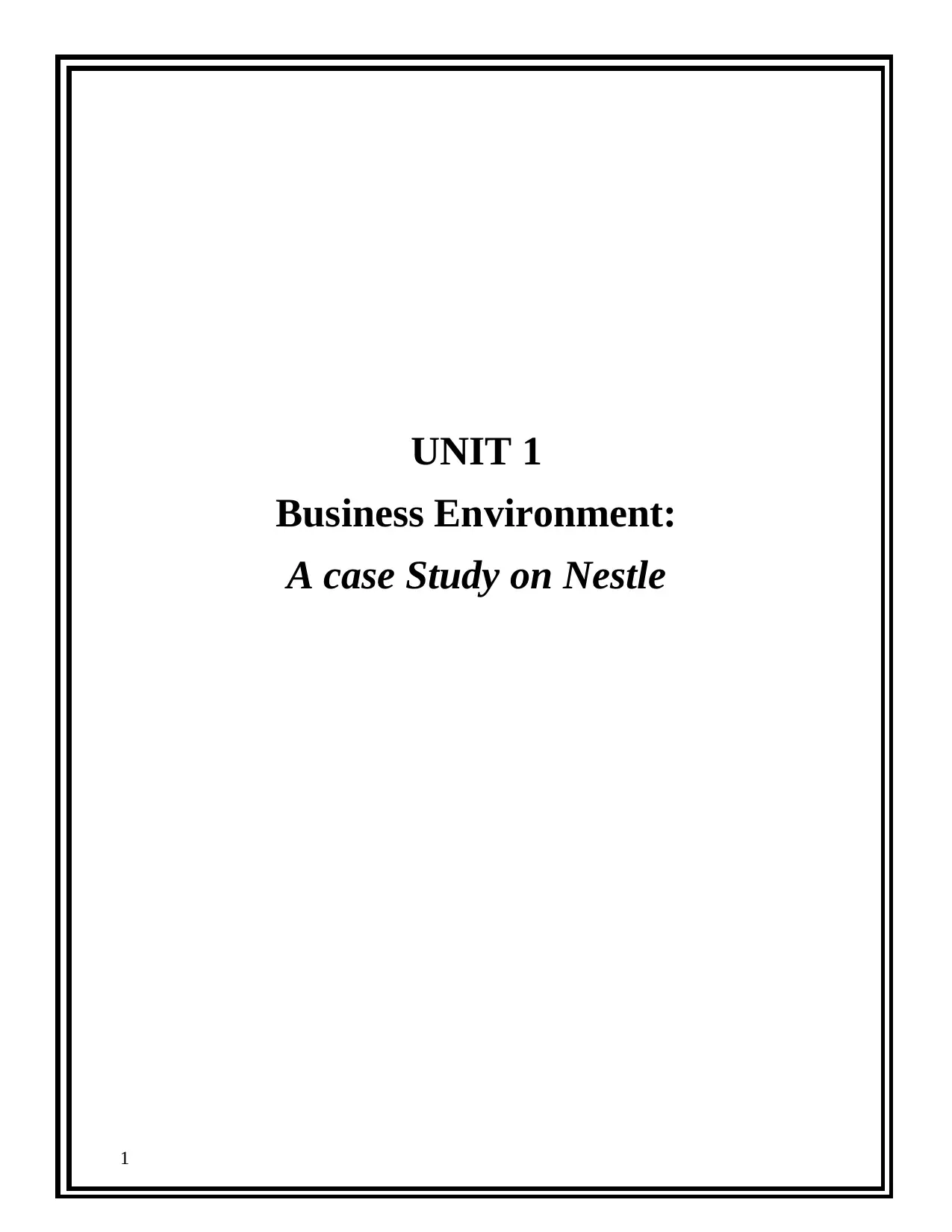
UNIT 1
Business Environment:
A case Study on Nestle
1
Business Environment:
A case Study on Nestle
1
Paraphrase This Document
Need a fresh take? Get an instant paraphrase of this document with our AI Paraphraser
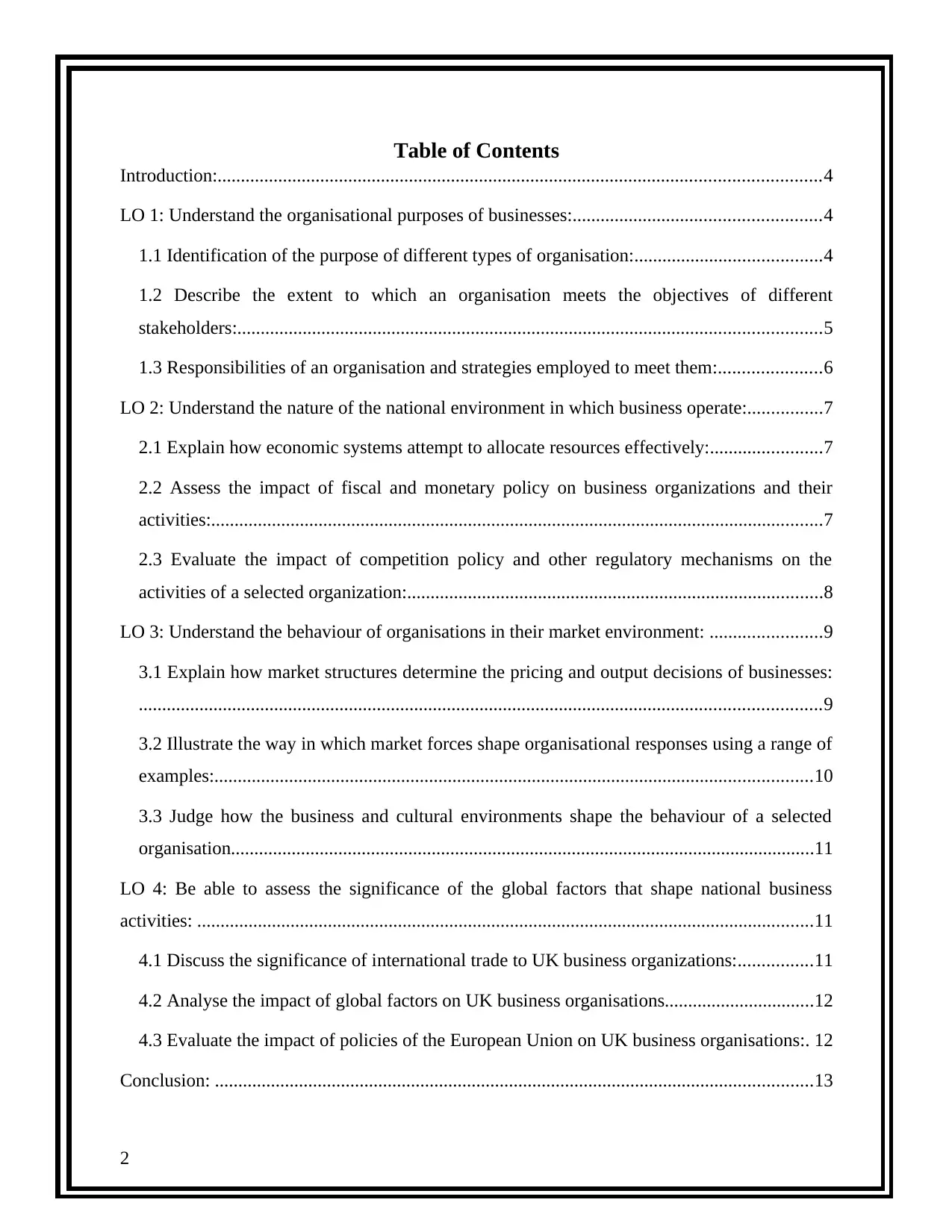
Table of Contents
Introduction:.................................................................................................................................4
LO 1: Understand the organisational purposes of businesses:.....................................................4
1.1 Identification of the purpose of different types of organisation:........................................4
1.2 Describe the extent to which an organisation meets the objectives of different
stakeholders:.............................................................................................................................5
1.3 Responsibilities of an organisation and strategies employed to meet them:......................6
LO 2: Understand the nature of the national environment in which business operate:................7
2.1 Explain how economic systems attempt to allocate resources effectively:........................7
2.2 Assess the impact of fiscal and monetary policy on business organizations and their
activities:...................................................................................................................................7
2.3 Evaluate the impact of competition policy and other regulatory mechanisms on the
activities of a selected organization:.........................................................................................8
LO 3: Understand the behaviour of organisations in their market environment: ........................9
3.1 Explain how market structures determine the pricing and output decisions of businesses:
..................................................................................................................................................9
3.2 Illustrate the way in which market forces shape organisational responses using a range of
examples:................................................................................................................................10
3.3 Judge how the business and cultural environments shape the behaviour of a selected
organisation.............................................................................................................................11
LO 4: Be able to assess the significance of the global factors that shape national business
activities: ....................................................................................................................................11
4.1 Discuss the significance of international trade to UK business organizations:................11
4.2 Analyse the impact of global factors on UK business organisations................................12
4.3 Evaluate the impact of policies of the European Union on UK business organisations:. 12
Conclusion: ................................................................................................................................13
2
Introduction:.................................................................................................................................4
LO 1: Understand the organisational purposes of businesses:.....................................................4
1.1 Identification of the purpose of different types of organisation:........................................4
1.2 Describe the extent to which an organisation meets the objectives of different
stakeholders:.............................................................................................................................5
1.3 Responsibilities of an organisation and strategies employed to meet them:......................6
LO 2: Understand the nature of the national environment in which business operate:................7
2.1 Explain how economic systems attempt to allocate resources effectively:........................7
2.2 Assess the impact of fiscal and monetary policy on business organizations and their
activities:...................................................................................................................................7
2.3 Evaluate the impact of competition policy and other regulatory mechanisms on the
activities of a selected organization:.........................................................................................8
LO 3: Understand the behaviour of organisations in their market environment: ........................9
3.1 Explain how market structures determine the pricing and output decisions of businesses:
..................................................................................................................................................9
3.2 Illustrate the way in which market forces shape organisational responses using a range of
examples:................................................................................................................................10
3.3 Judge how the business and cultural environments shape the behaviour of a selected
organisation.............................................................................................................................11
LO 4: Be able to assess the significance of the global factors that shape national business
activities: ....................................................................................................................................11
4.1 Discuss the significance of international trade to UK business organizations:................11
4.2 Analyse the impact of global factors on UK business organisations................................12
4.3 Evaluate the impact of policies of the European Union on UK business organisations:. 12
Conclusion: ................................................................................................................................13
2

References...................................................................................................................................14
3
3
⊘ This is a preview!⊘
Do you want full access?
Subscribe today to unlock all pages.

Trusted by 1+ million students worldwide
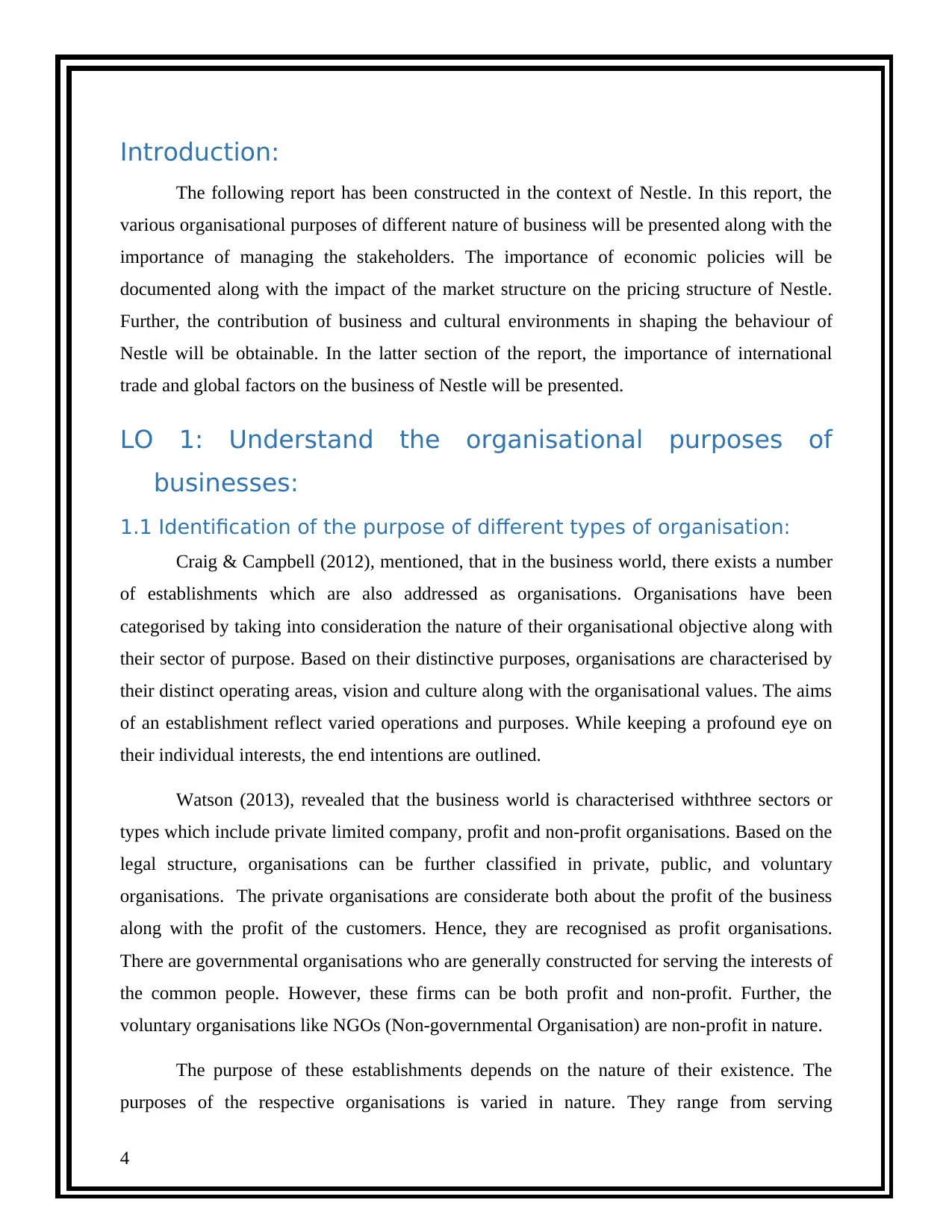
Introduction:
The following report has been constructed in the context of Nestle. In this report, the
various organisational purposes of different nature of business will be presented along with the
importance of managing the stakeholders. The importance of economic policies will be
documented along with the impact of the market structure on the pricing structure of Nestle.
Further, the contribution of business and cultural environments in shaping the behaviour of
Nestle will be obtainable. In the latter section of the report, the importance of international
trade and global factors on the business of Nestle will be presented.
LO 1: Understand the organisational purposes of
businesses:
1.1 Identification of the purpose of different types of organisation:
Craig & Campbell (2012), mentioned, that in the business world, there exists a number
of establishments which are also addressed as organisations. Organisations have been
categorised by taking into consideration the nature of their organisational objective along with
their sector of purpose. Based on their distinctive purposes, organisations are characterised by
their distinct operating areas, vision and culture along with the organisational values. The aims
of an establishment reflect varied operations and purposes. While keeping a profound eye on
their individual interests, the end intentions are outlined.
Watson (2013), revealed that the business world is characterised withthree sectors or
types which include private limited company, profit and non-profit organisations. Based on the
legal structure, organisations can be further classified in private, public, and voluntary
organisations. The private organisations are considerate both about the profit of the business
along with the profit of the customers. Hence, they are recognised as profit organisations.
There are governmental organisations who are generally constructed for serving the interests of
the common people. However, these firms can be both profit and non-profit. Further, the
voluntary organisations like NGOs (Non-governmental Organisation) are non-profit in nature.
The purpose of these establishments depends on the nature of their existence. The
purposes of the respective organisations is varied in nature. They range from serving
4
The following report has been constructed in the context of Nestle. In this report, the
various organisational purposes of different nature of business will be presented along with the
importance of managing the stakeholders. The importance of economic policies will be
documented along with the impact of the market structure on the pricing structure of Nestle.
Further, the contribution of business and cultural environments in shaping the behaviour of
Nestle will be obtainable. In the latter section of the report, the importance of international
trade and global factors on the business of Nestle will be presented.
LO 1: Understand the organisational purposes of
businesses:
1.1 Identification of the purpose of different types of organisation:
Craig & Campbell (2012), mentioned, that in the business world, there exists a number
of establishments which are also addressed as organisations. Organisations have been
categorised by taking into consideration the nature of their organisational objective along with
their sector of purpose. Based on their distinctive purposes, organisations are characterised by
their distinct operating areas, vision and culture along with the organisational values. The aims
of an establishment reflect varied operations and purposes. While keeping a profound eye on
their individual interests, the end intentions are outlined.
Watson (2013), revealed that the business world is characterised withthree sectors or
types which include private limited company, profit and non-profit organisations. Based on the
legal structure, organisations can be further classified in private, public, and voluntary
organisations. The private organisations are considerate both about the profit of the business
along with the profit of the customers. Hence, they are recognised as profit organisations.
There are governmental organisations who are generally constructed for serving the interests of
the common people. However, these firms can be both profit and non-profit. Further, the
voluntary organisations like NGOs (Non-governmental Organisation) are non-profit in nature.
The purpose of these establishments depends on the nature of their existence. The
purposes of the respective organisations is varied in nature. They range from serving
4
Paraphrase This Document
Need a fresh take? Get an instant paraphrase of this document with our AI Paraphraser
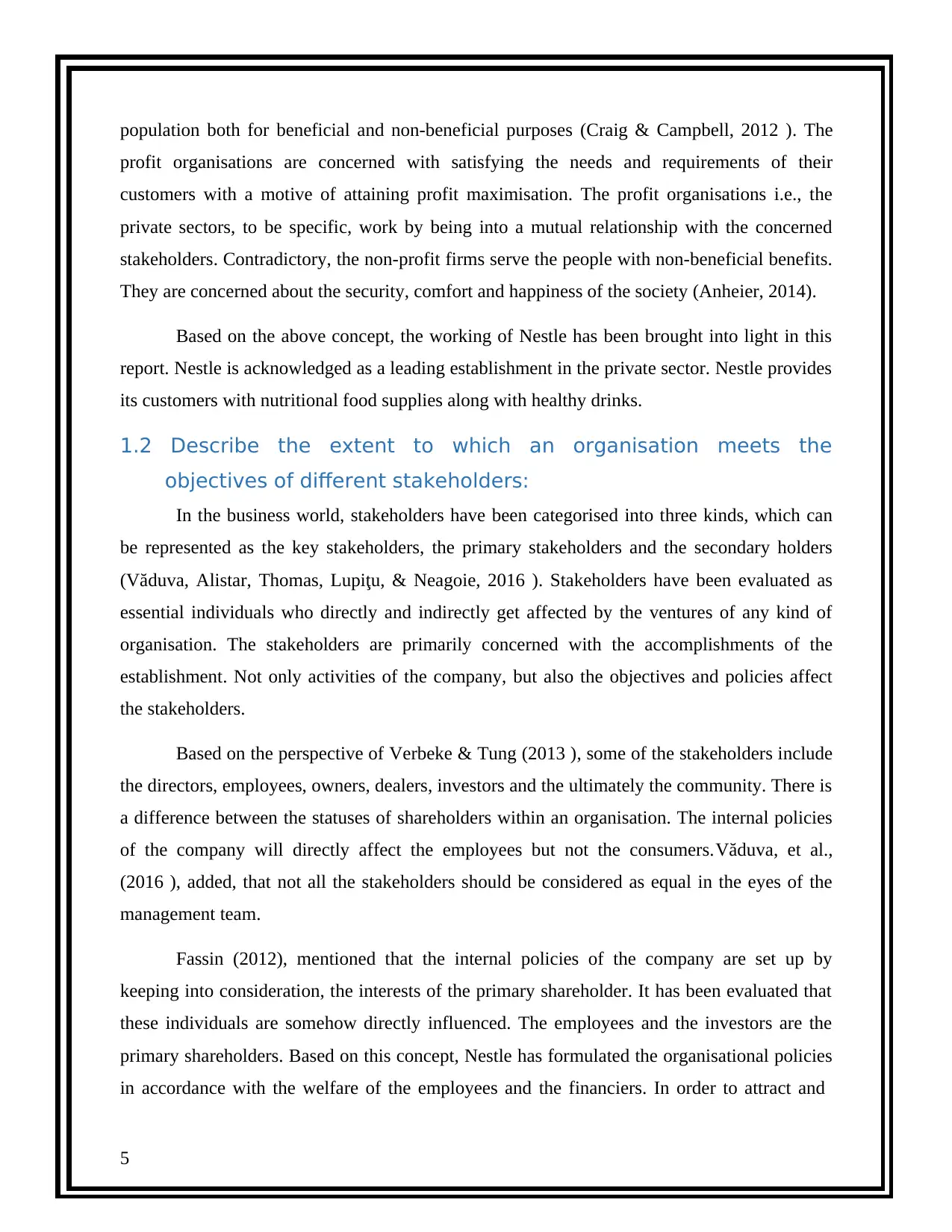
population both for beneficial and non-beneficial purposes (Craig & Campbell, 2012 ). The
profit organisations are concerned with satisfying the needs and requirements of their
customers with a motive of attaining profit maximisation. The profit organisations i.e., the
private sectors, to be specific, work by being into a mutual relationship with the concerned
stakeholders. Contradictory, the non-profit firms serve the people with non-beneficial benefits.
They are concerned about the security, comfort and happiness of the society (Anheier, 2014).
Based on the above concept, the working of Nestle has been brought into light in this
report. Nestle is acknowledged as a leading establishment in the private sector. Nestle provides
its customers with nutritional food supplies along with healthy drinks.
1.2 Describe the extent to which an organisation meets the
objectives of different stakeholders:
In the business world, stakeholders have been categorised into three kinds, which can
be represented as the key stakeholders, the primary stakeholders and the secondary holders
(Văduva, Alistar, Thomas, Lupiţu, & Neagoie, 2016 ). Stakeholders have been evaluated as
essential individuals who directly and indirectly get affected by the ventures of any kind of
organisation. The stakeholders are primarily concerned with the accomplishments of the
establishment. Not only activities of the company, but also the objectives and policies affect
the stakeholders.
Based on the perspective of Verbeke & Tung (2013 ), some of the stakeholders include
the directors, employees, owners, dealers, investors and the ultimately the community. There is
a difference between the statuses of shareholders within an organisation. The internal policies
of the company will directly affect the employees but not the consumers.Văduva, et al.,
(2016 ), added, that not all the stakeholders should be considered as equal in the eyes of the
management team.
Fassin (2012), mentioned that the internal policies of the company are set up by
keeping into consideration, the interests of the primary shareholder. It has been evaluated that
these individuals are somehow directly influenced. The employees and the investors are the
primary shareholders. Based on this concept, Nestle has formulated the organisational policies
in accordance with the welfare of the employees and the financiers. In order to attract and
5
profit organisations are concerned with satisfying the needs and requirements of their
customers with a motive of attaining profit maximisation. The profit organisations i.e., the
private sectors, to be specific, work by being into a mutual relationship with the concerned
stakeholders. Contradictory, the non-profit firms serve the people with non-beneficial benefits.
They are concerned about the security, comfort and happiness of the society (Anheier, 2014).
Based on the above concept, the working of Nestle has been brought into light in this
report. Nestle is acknowledged as a leading establishment in the private sector. Nestle provides
its customers with nutritional food supplies along with healthy drinks.
1.2 Describe the extent to which an organisation meets the
objectives of different stakeholders:
In the business world, stakeholders have been categorised into three kinds, which can
be represented as the key stakeholders, the primary stakeholders and the secondary holders
(Văduva, Alistar, Thomas, Lupiţu, & Neagoie, 2016 ). Stakeholders have been evaluated as
essential individuals who directly and indirectly get affected by the ventures of any kind of
organisation. The stakeholders are primarily concerned with the accomplishments of the
establishment. Not only activities of the company, but also the objectives and policies affect
the stakeholders.
Based on the perspective of Verbeke & Tung (2013 ), some of the stakeholders include
the directors, employees, owners, dealers, investors and the ultimately the community. There is
a difference between the statuses of shareholders within an organisation. The internal policies
of the company will directly affect the employees but not the consumers.Văduva, et al.,
(2016 ), added, that not all the stakeholders should be considered as equal in the eyes of the
management team.
Fassin (2012), mentioned that the internal policies of the company are set up by
keeping into consideration, the interests of the primary shareholder. It has been evaluated that
these individuals are somehow directly influenced. The employees and the investors are the
primary shareholders. Based on this concept, Nestle has formulated the organisational policies
in accordance with the welfare of the employees and the financiers. In order to attract and
5
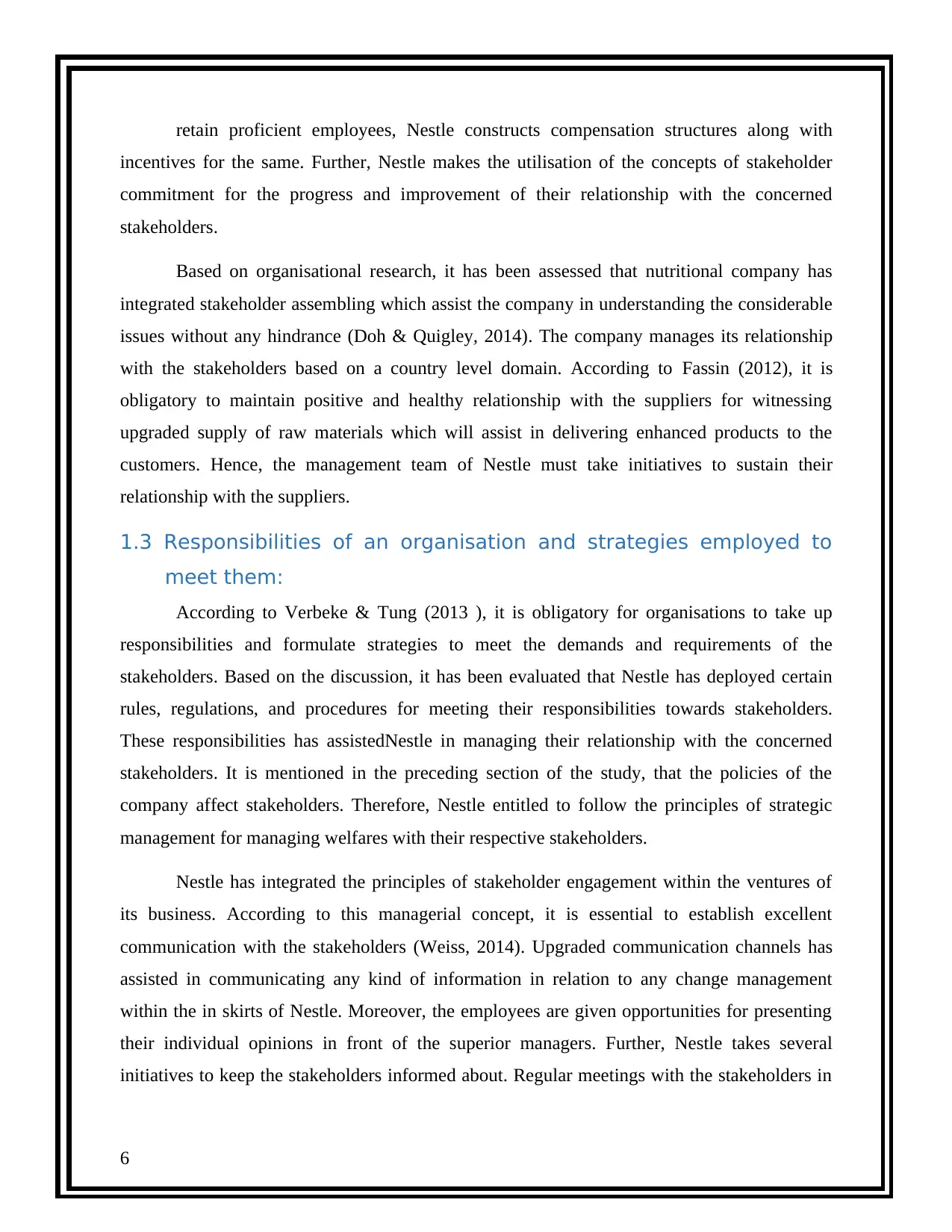
retain proficient employees, Nestle constructs compensation structures along with
incentives for the same. Further, Nestle makes the utilisation of the concepts of stakeholder
commitment for the progress and improvement of their relationship with the concerned
stakeholders.
Based on organisational research, it has been assessed that nutritional company has
integrated stakeholder assembling which assist the company in understanding the considerable
issues without any hindrance (Doh & Quigley, 2014). The company manages its relationship
with the stakeholders based on a country level domain. According to Fassin (2012), it is
obligatory to maintain positive and healthy relationship with the suppliers for witnessing
upgraded supply of raw materials which will assist in delivering enhanced products to the
customers. Hence, the management team of Nestle must take initiatives to sustain their
relationship with the suppliers.
1.3 Responsibilities of an organisation and strategies employed to
meet them:
According to Verbeke & Tung (2013 ), it is obligatory for organisations to take up
responsibilities and formulate strategies to meet the demands and requirements of the
stakeholders. Based on the discussion, it has been evaluated that Nestle has deployed certain
rules, regulations, and procedures for meeting their responsibilities towards stakeholders.
These responsibilities has assistedNestle in managing their relationship with the concerned
stakeholders. It is mentioned in the preceding section of the study, that the policies of the
company affect stakeholders. Therefore, Nestle entitled to follow the principles of strategic
management for managing welfares with their respective stakeholders.
Nestle has integrated the principles of stakeholder engagement within the ventures of
its business. According to this managerial concept, it is essential to establish excellent
communication with the stakeholders (Weiss, 2014). Upgraded communication channels has
assisted in communicating any kind of information in relation to any change management
within the in skirts of Nestle. Moreover, the employees are given opportunities for presenting
their individual opinions in front of the superior managers. Further, Nestle takes several
initiatives to keep the stakeholders informed about. Regular meetings with the stakeholders in
6
incentives for the same. Further, Nestle makes the utilisation of the concepts of stakeholder
commitment for the progress and improvement of their relationship with the concerned
stakeholders.
Based on organisational research, it has been assessed that nutritional company has
integrated stakeholder assembling which assist the company in understanding the considerable
issues without any hindrance (Doh & Quigley, 2014). The company manages its relationship
with the stakeholders based on a country level domain. According to Fassin (2012), it is
obligatory to maintain positive and healthy relationship with the suppliers for witnessing
upgraded supply of raw materials which will assist in delivering enhanced products to the
customers. Hence, the management team of Nestle must take initiatives to sustain their
relationship with the suppliers.
1.3 Responsibilities of an organisation and strategies employed to
meet them:
According to Verbeke & Tung (2013 ), it is obligatory for organisations to take up
responsibilities and formulate strategies to meet the demands and requirements of the
stakeholders. Based on the discussion, it has been evaluated that Nestle has deployed certain
rules, regulations, and procedures for meeting their responsibilities towards stakeholders.
These responsibilities has assistedNestle in managing their relationship with the concerned
stakeholders. It is mentioned in the preceding section of the study, that the policies of the
company affect stakeholders. Therefore, Nestle entitled to follow the principles of strategic
management for managing welfares with their respective stakeholders.
Nestle has integrated the principles of stakeholder engagement within the ventures of
its business. According to this managerial concept, it is essential to establish excellent
communication with the stakeholders (Weiss, 2014). Upgraded communication channels has
assisted in communicating any kind of information in relation to any change management
within the in skirts of Nestle. Moreover, the employees are given opportunities for presenting
their individual opinions in front of the superior managers. Further, Nestle takes several
initiatives to keep the stakeholders informed about. Regular meetings with the stakeholders in
6
⊘ This is a preview!⊘
Do you want full access?
Subscribe today to unlock all pages.

Trusted by 1+ million students worldwide
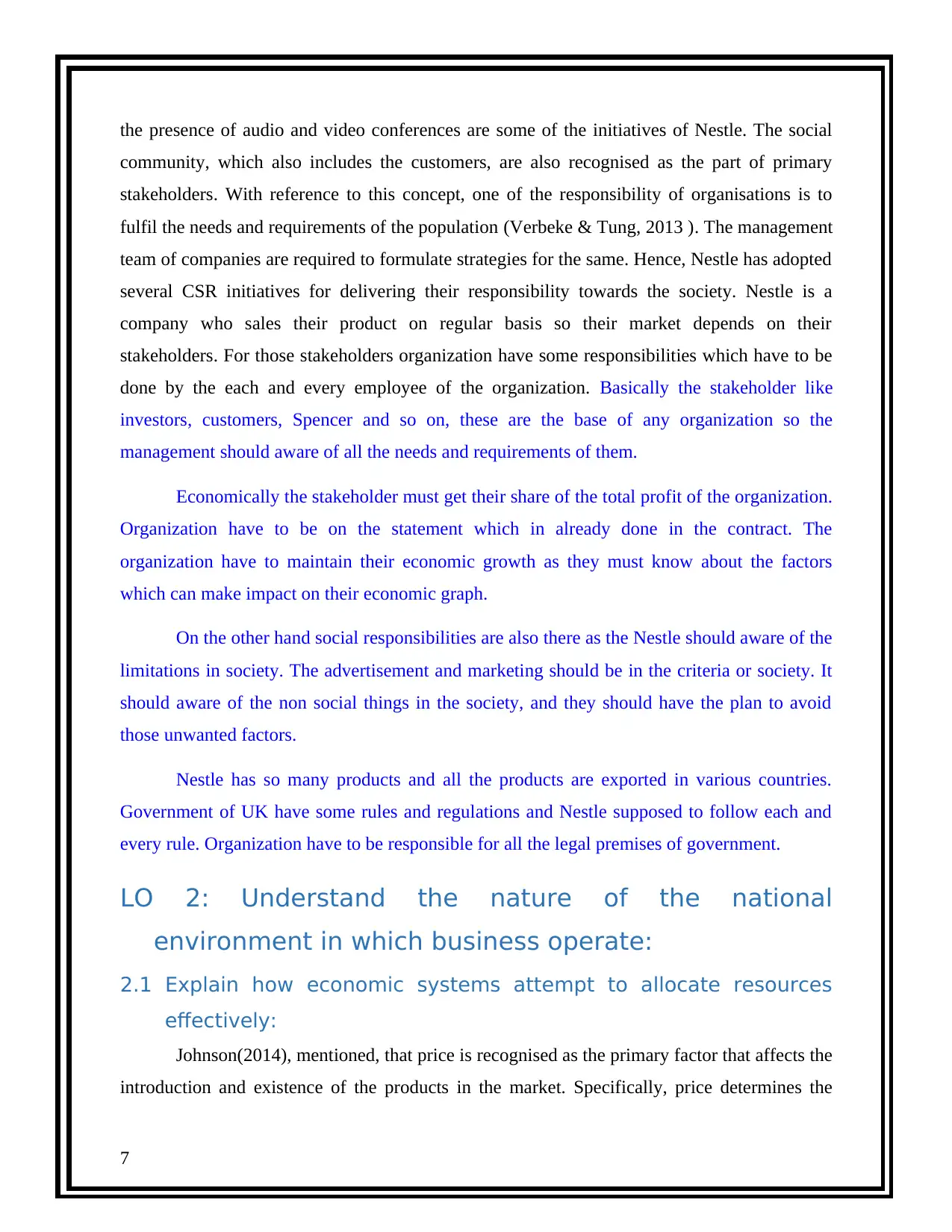
the presence of audio and video conferences are some of the initiatives of Nestle. The social
community, which also includes the customers, are also recognised as the part of primary
stakeholders. With reference to this concept, one of the responsibility of organisations is to
fulfil the needs and requirements of the population (Verbeke & Tung, 2013 ). The management
team of companies are required to formulate strategies for the same. Hence, Nestle has adopted
several CSR initiatives for delivering their responsibility towards the society. Nestle is a
company who sales their product on regular basis so their market depends on their
stakeholders. For those stakeholders organization have some responsibilities which have to be
done by the each and every employee of the organization. Basically the stakeholder like
investors, customers, Spencer and so on, these are the base of any organization so the
management should aware of all the needs and requirements of them.
Economically the stakeholder must get their share of the total profit of the organization.
Organization have to be on the statement which in already done in the contract. The
organization have to maintain their economic growth as they must know about the factors
which can make impact on their economic graph.
On the other hand social responsibilities are also there as the Nestle should aware of the
limitations in society. The advertisement and marketing should be in the criteria or society. It
should aware of the non social things in the society, and they should have the plan to avoid
those unwanted factors.
Nestle has so many products and all the products are exported in various countries.
Government of UK have some rules and regulations and Nestle supposed to follow each and
every rule. Organization have to be responsible for all the legal premises of government.
LO 2: Understand the nature of the national
environment in which business operate:
2.1 Explain how economic systems attempt to allocate resources
effectively:
Johnson(2014), mentioned, that price is recognised as the primary factor that affects the
introduction and existence of the products in the market. Specifically, price determines the
7
community, which also includes the customers, are also recognised as the part of primary
stakeholders. With reference to this concept, one of the responsibility of organisations is to
fulfil the needs and requirements of the population (Verbeke & Tung, 2013 ). The management
team of companies are required to formulate strategies for the same. Hence, Nestle has adopted
several CSR initiatives for delivering their responsibility towards the society. Nestle is a
company who sales their product on regular basis so their market depends on their
stakeholders. For those stakeholders organization have some responsibilities which have to be
done by the each and every employee of the organization. Basically the stakeholder like
investors, customers, Spencer and so on, these are the base of any organization so the
management should aware of all the needs and requirements of them.
Economically the stakeholder must get their share of the total profit of the organization.
Organization have to be on the statement which in already done in the contract. The
organization have to maintain their economic growth as they must know about the factors
which can make impact on their economic graph.
On the other hand social responsibilities are also there as the Nestle should aware of the
limitations in society. The advertisement and marketing should be in the criteria or society. It
should aware of the non social things in the society, and they should have the plan to avoid
those unwanted factors.
Nestle has so many products and all the products are exported in various countries.
Government of UK have some rules and regulations and Nestle supposed to follow each and
every rule. Organization have to be responsible for all the legal premises of government.
LO 2: Understand the nature of the national
environment in which business operate:
2.1 Explain how economic systems attempt to allocate resources
effectively:
Johnson(2014), mentioned, that price is recognised as the primary factor that affects the
introduction and existence of the products in the market. Specifically, price determines the
7
Paraphrase This Document
Need a fresh take? Get an instant paraphrase of this document with our AI Paraphraser
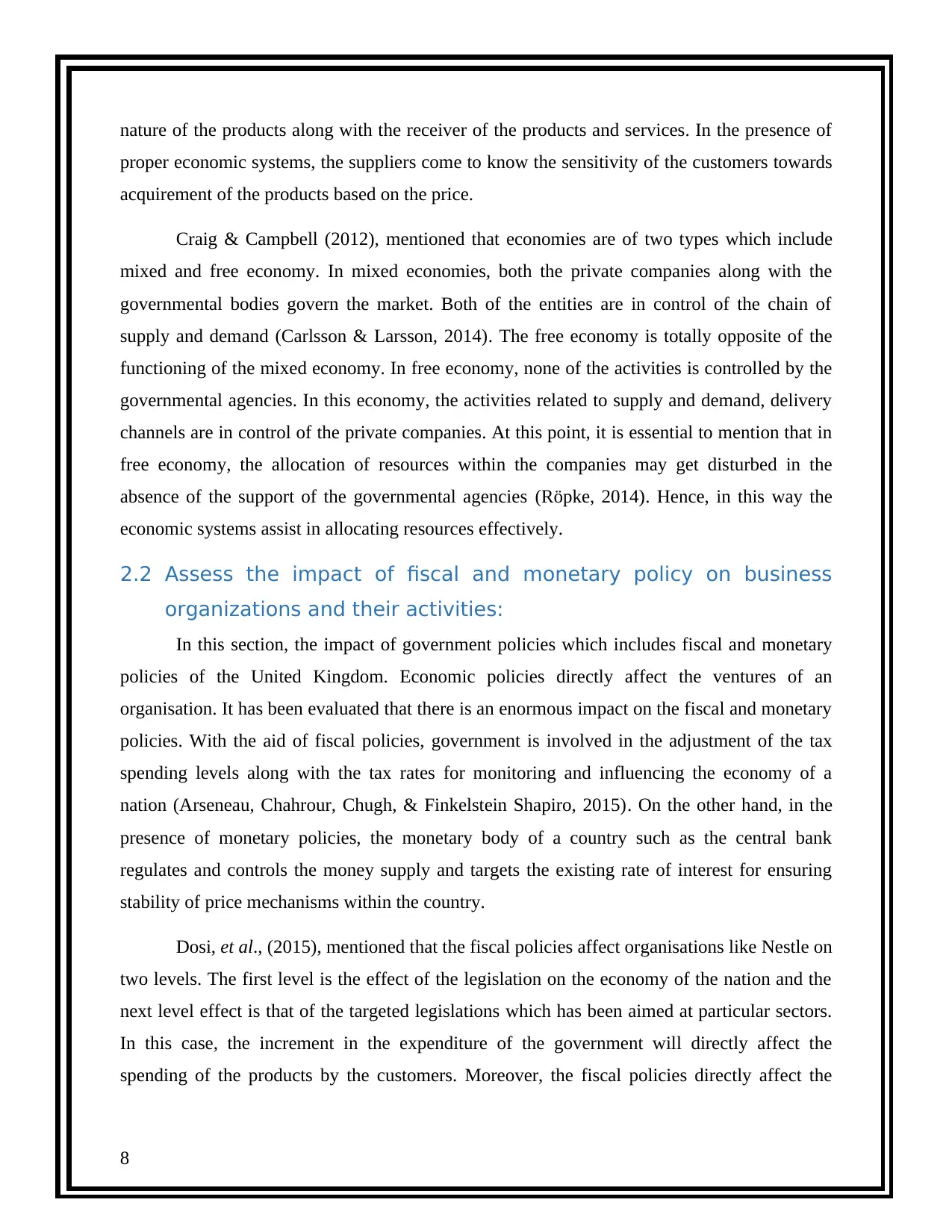
nature of the products along with the receiver of the products and services. In the presence of
proper economic systems, the suppliers come to know the sensitivity of the customers towards
acquirement of the products based on the price.
Craig & Campbell (2012), mentioned that economies are of two types which include
mixed and free economy. In mixed economies, both the private companies along with the
governmental bodies govern the market. Both of the entities are in control of the chain of
supply and demand (Carlsson & Larsson, 2014). The free economy is totally opposite of the
functioning of the mixed economy. In free economy, none of the activities is controlled by the
governmental agencies. In this economy, the activities related to supply and demand, delivery
channels are in control of the private companies. At this point, it is essential to mention that in
free economy, the allocation of resources within the companies may get disturbed in the
absence of the support of the governmental agencies (Röpke, 2014). Hence, in this way the
economic systems assist in allocating resources effectively.
2.2 Assess the impact of fiscal and monetary policy on business
organizations and their activities:
In this section, the impact of government policies which includes fiscal and monetary
policies of the United Kingdom. Economic policies directly affect the ventures of an
organisation. It has been evaluated that there is an enormous impact on the fiscal and monetary
policies. With the aid of fiscal policies, government is involved in the adjustment of the tax
spending levels along with the tax rates for monitoring and influencing the economy of a
nation (Arseneau, Chahrour, Chugh, & Finkelstein Shapiro, 2015). On the other hand, in the
presence of monetary policies, the monetary body of a country such as the central bank
regulates and controls the money supply and targets the existing rate of interest for ensuring
stability of price mechanisms within the country.
Dosi, et al., (2015), mentioned that the fiscal policies affect organisations like Nestle on
two levels. The first level is the effect of the legislation on the economy of the nation and the
next level effect is that of the targeted legislations which has been aimed at particular sectors.
In this case, the increment in the expenditure of the government will directly affect the
spending of the products by the customers. Moreover, the fiscal policies directly affect the
8
proper economic systems, the suppliers come to know the sensitivity of the customers towards
acquirement of the products based on the price.
Craig & Campbell (2012), mentioned that economies are of two types which include
mixed and free economy. In mixed economies, both the private companies along with the
governmental bodies govern the market. Both of the entities are in control of the chain of
supply and demand (Carlsson & Larsson, 2014). The free economy is totally opposite of the
functioning of the mixed economy. In free economy, none of the activities is controlled by the
governmental agencies. In this economy, the activities related to supply and demand, delivery
channels are in control of the private companies. At this point, it is essential to mention that in
free economy, the allocation of resources within the companies may get disturbed in the
absence of the support of the governmental agencies (Röpke, 2014). Hence, in this way the
economic systems assist in allocating resources effectively.
2.2 Assess the impact of fiscal and monetary policy on business
organizations and their activities:
In this section, the impact of government policies which includes fiscal and monetary
policies of the United Kingdom. Economic policies directly affect the ventures of an
organisation. It has been evaluated that there is an enormous impact on the fiscal and monetary
policies. With the aid of fiscal policies, government is involved in the adjustment of the tax
spending levels along with the tax rates for monitoring and influencing the economy of a
nation (Arseneau, Chahrour, Chugh, & Finkelstein Shapiro, 2015). On the other hand, in the
presence of monetary policies, the monetary body of a country such as the central bank
regulates and controls the money supply and targets the existing rate of interest for ensuring
stability of price mechanisms within the country.
Dosi, et al., (2015), mentioned that the fiscal policies affect organisations like Nestle on
two levels. The first level is the effect of the legislation on the economy of the nation and the
next level effect is that of the targeted legislations which has been aimed at particular sectors.
In this case, the increment in the expenditure of the government will directly affect the
spending of the products by the customers. Moreover, the fiscal policies directly affect the
8
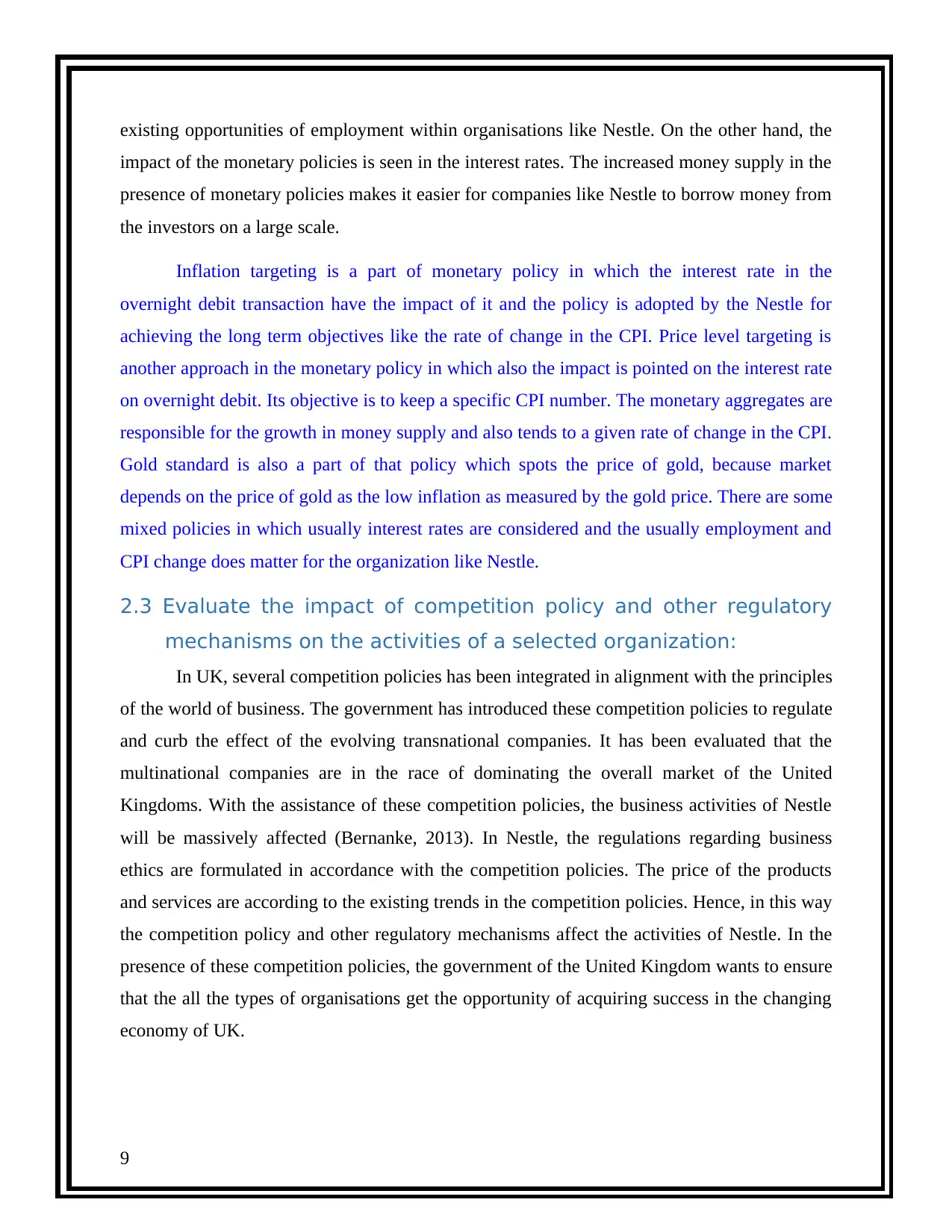
existing opportunities of employment within organisations like Nestle. On the other hand, the
impact of the monetary policies is seen in the interest rates. The increased money supply in the
presence of monetary policies makes it easier for companies like Nestle to borrow money from
the investors on a large scale.
Inflation targeting is a part of monetary policy in which the interest rate in the
overnight debit transaction have the impact of it and the policy is adopted by the Nestle for
achieving the long term objectives like the rate of change in the CPI. Price level targeting is
another approach in the monetary policy in which also the impact is pointed on the interest rate
on overnight debit. Its objective is to keep a specific CPI number. The monetary aggregates are
responsible for the growth in money supply and also tends to a given rate of change in the CPI.
Gold standard is also a part of that policy which spots the price of gold, because market
depends on the price of gold as the low inflation as measured by the gold price. There are some
mixed policies in which usually interest rates are considered and the usually employment and
CPI change does matter for the organization like Nestle.
2.3 Evaluate the impact of competition policy and other regulatory
mechanisms on the activities of a selected organization:
In UK, several competition policies has been integrated in alignment with the principles
of the world of business. The government has introduced these competition policies to regulate
and curb the effect of the evolving transnational companies. It has been evaluated that the
multinational companies are in the race of dominating the overall market of the United
Kingdoms. With the assistance of these competition policies, the business activities of Nestle
will be massively affected (Bernanke, 2013). In Nestle, the regulations regarding business
ethics are formulated in accordance with the competition policies. The price of the products
and services are according to the existing trends in the competition policies. Hence, in this way
the competition policy and other regulatory mechanisms affect the activities of Nestle. In the
presence of these competition policies, the government of the United Kingdom wants to ensure
that the all the types of organisations get the opportunity of acquiring success in the changing
economy of UK.
9
impact of the monetary policies is seen in the interest rates. The increased money supply in the
presence of monetary policies makes it easier for companies like Nestle to borrow money from
the investors on a large scale.
Inflation targeting is a part of monetary policy in which the interest rate in the
overnight debit transaction have the impact of it and the policy is adopted by the Nestle for
achieving the long term objectives like the rate of change in the CPI. Price level targeting is
another approach in the monetary policy in which also the impact is pointed on the interest rate
on overnight debit. Its objective is to keep a specific CPI number. The monetary aggregates are
responsible for the growth in money supply and also tends to a given rate of change in the CPI.
Gold standard is also a part of that policy which spots the price of gold, because market
depends on the price of gold as the low inflation as measured by the gold price. There are some
mixed policies in which usually interest rates are considered and the usually employment and
CPI change does matter for the organization like Nestle.
2.3 Evaluate the impact of competition policy and other regulatory
mechanisms on the activities of a selected organization:
In UK, several competition policies has been integrated in alignment with the principles
of the world of business. The government has introduced these competition policies to regulate
and curb the effect of the evolving transnational companies. It has been evaluated that the
multinational companies are in the race of dominating the overall market of the United
Kingdoms. With the assistance of these competition policies, the business activities of Nestle
will be massively affected (Bernanke, 2013). In Nestle, the regulations regarding business
ethics are formulated in accordance with the competition policies. The price of the products
and services are according to the existing trends in the competition policies. Hence, in this way
the competition policy and other regulatory mechanisms affect the activities of Nestle. In the
presence of these competition policies, the government of the United Kingdom wants to ensure
that the all the types of organisations get the opportunity of acquiring success in the changing
economy of UK.
9
⊘ This is a preview!⊘
Do you want full access?
Subscribe today to unlock all pages.

Trusted by 1+ million students worldwide
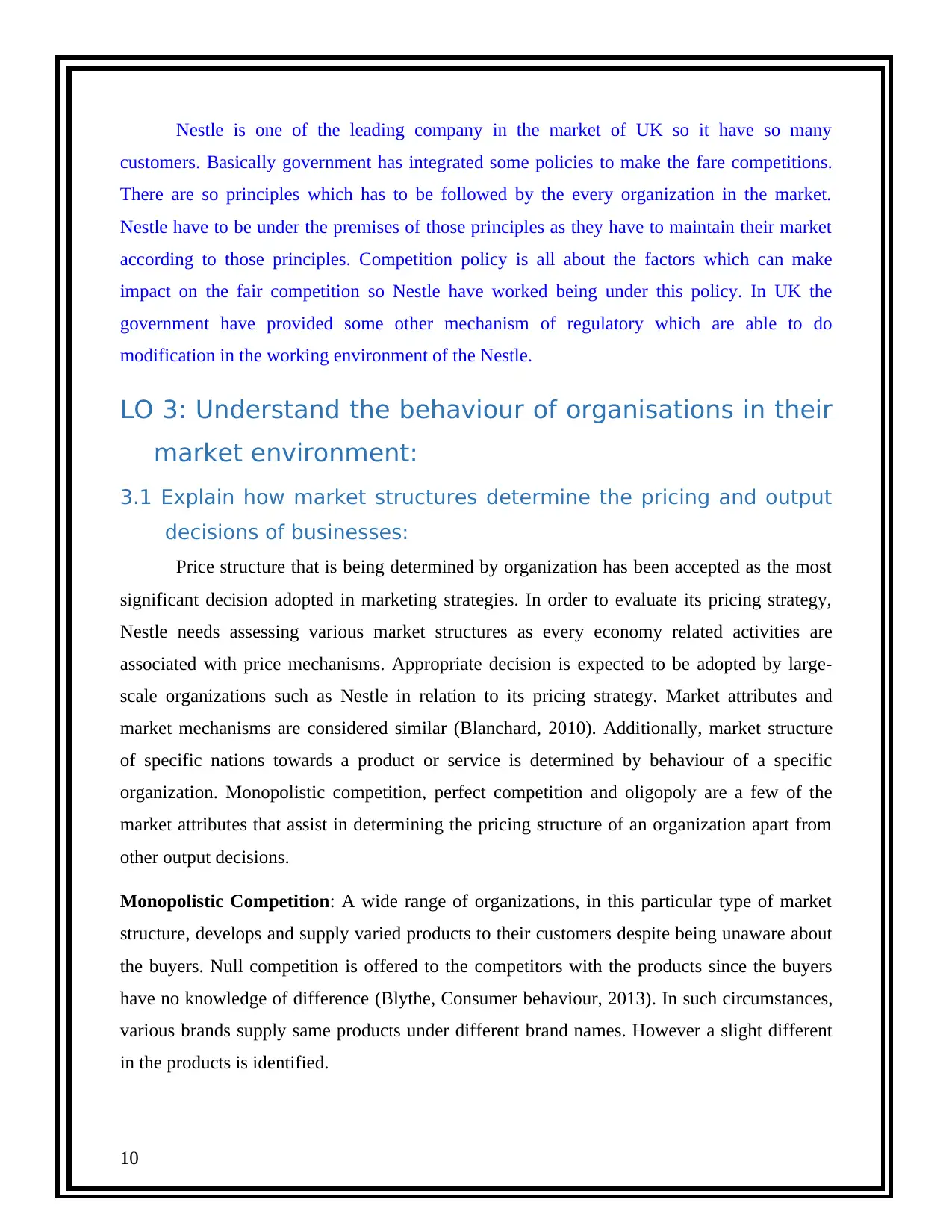
Nestle is one of the leading company in the market of UK so it have so many
customers. Basically government has integrated some policies to make the fare competitions.
There are so principles which has to be followed by the every organization in the market.
Nestle have to be under the premises of those principles as they have to maintain their market
according to those principles. Competition policy is all about the factors which can make
impact on the fair competition so Nestle have worked being under this policy. In UK the
government have provided some other mechanism of regulatory which are able to do
modification in the working environment of the Nestle.
LO 3: Understand the behaviour of organisations in their
market environment:
3.1 Explain how market structures determine the pricing and output
decisions of businesses:
Price structure that is being determined by organization has been accepted as the most
significant decision adopted in marketing strategies. In order to evaluate its pricing strategy,
Nestle needs assessing various market structures as every economy related activities are
associated with price mechanisms. Appropriate decision is expected to be adopted by large-
scale organizations such as Nestle in relation to its pricing strategy. Market attributes and
market mechanisms are considered similar (Blanchard, 2010). Additionally, market structure
of specific nations towards a product or service is determined by behaviour of a specific
organization. Monopolistic competition, perfect competition and oligopoly are a few of the
market attributes that assist in determining the pricing structure of an organization apart from
other output decisions.
Monopolistic Competition: A wide range of organizations, in this particular type of market
structure, develops and supply varied products to their customers despite being unaware about
the buyers. Null competition is offered to the competitors with the products since the buyers
have no knowledge of difference (Blythe, Consumer behaviour, 2013). In such circumstances,
various brands supply same products under different brand names. However a slight different
in the products is identified.
10
customers. Basically government has integrated some policies to make the fare competitions.
There are so principles which has to be followed by the every organization in the market.
Nestle have to be under the premises of those principles as they have to maintain their market
according to those principles. Competition policy is all about the factors which can make
impact on the fair competition so Nestle have worked being under this policy. In UK the
government have provided some other mechanism of regulatory which are able to do
modification in the working environment of the Nestle.
LO 3: Understand the behaviour of organisations in their
market environment:
3.1 Explain how market structures determine the pricing and output
decisions of businesses:
Price structure that is being determined by organization has been accepted as the most
significant decision adopted in marketing strategies. In order to evaluate its pricing strategy,
Nestle needs assessing various market structures as every economy related activities are
associated with price mechanisms. Appropriate decision is expected to be adopted by large-
scale organizations such as Nestle in relation to its pricing strategy. Market attributes and
market mechanisms are considered similar (Blanchard, 2010). Additionally, market structure
of specific nations towards a product or service is determined by behaviour of a specific
organization. Monopolistic competition, perfect competition and oligopoly are a few of the
market attributes that assist in determining the pricing structure of an organization apart from
other output decisions.
Monopolistic Competition: A wide range of organizations, in this particular type of market
structure, develops and supply varied products to their customers despite being unaware about
the buyers. Null competition is offered to the competitors with the products since the buyers
have no knowledge of difference (Blythe, Consumer behaviour, 2013). In such circumstances,
various brands supply same products under different brand names. However a slight different
in the products is identified.
10
Paraphrase This Document
Need a fresh take? Get an instant paraphrase of this document with our AI Paraphraser
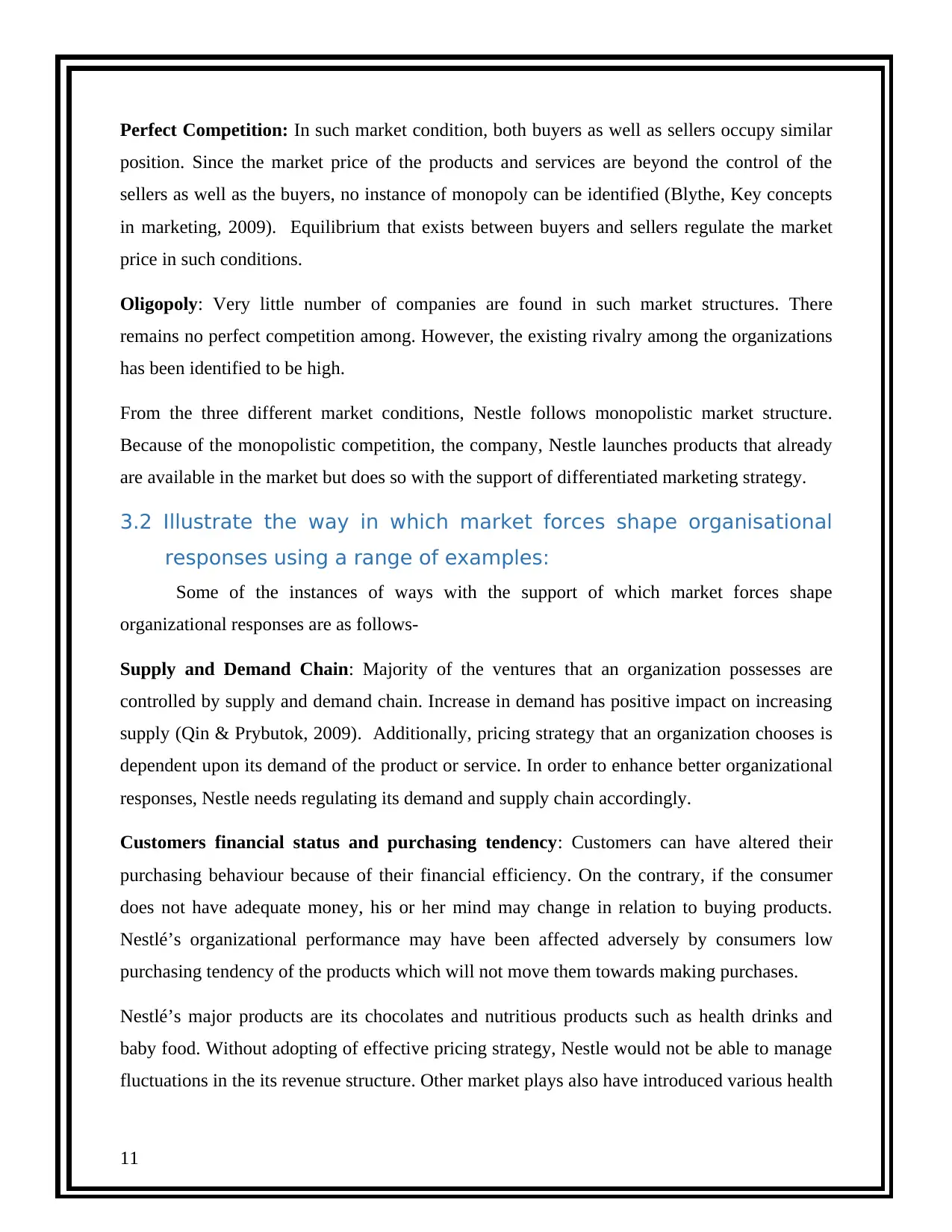
Perfect Competition: In such market condition, both buyers as well as sellers occupy similar
position. Since the market price of the products and services are beyond the control of the
sellers as well as the buyers, no instance of monopoly can be identified (Blythe, Key concepts
in marketing, 2009). Equilibrium that exists between buyers and sellers regulate the market
price in such conditions.
Oligopoly: Very little number of companies are found in such market structures. There
remains no perfect competition among. However, the existing rivalry among the organizations
has been identified to be high.
From the three different market conditions, Nestle follows monopolistic market structure.
Because of the monopolistic competition, the company, Nestle launches products that already
are available in the market but does so with the support of differentiated marketing strategy.
3.2 Illustrate the way in which market forces shape organisational
responses using a range of examples:
Some of the instances of ways with the support of which market forces shape
organizational responses are as follows-
Supply and Demand Chain: Majority of the ventures that an organization possesses are
controlled by supply and demand chain. Increase in demand has positive impact on increasing
supply (Qin & Prybutok, 2009). Additionally, pricing strategy that an organization chooses is
dependent upon its demand of the product or service. In order to enhance better organizational
responses, Nestle needs regulating its demand and supply chain accordingly.
Customers financial status and purchasing tendency: Customers can have altered their
purchasing behaviour because of their financial efficiency. On the contrary, if the consumer
does not have adequate money, his or her mind may change in relation to buying products.
Nestlé’s organizational performance may have been affected adversely by consumers low
purchasing tendency of the products which will not move them towards making purchases.
Nestlé’s major products are its chocolates and nutritious products such as health drinks and
baby food. Without adopting of effective pricing strategy, Nestle would not be able to manage
fluctuations in the its revenue structure. Other market plays also have introduced various health
11
position. Since the market price of the products and services are beyond the control of the
sellers as well as the buyers, no instance of monopoly can be identified (Blythe, Key concepts
in marketing, 2009). Equilibrium that exists between buyers and sellers regulate the market
price in such conditions.
Oligopoly: Very little number of companies are found in such market structures. There
remains no perfect competition among. However, the existing rivalry among the organizations
has been identified to be high.
From the three different market conditions, Nestle follows monopolistic market structure.
Because of the monopolistic competition, the company, Nestle launches products that already
are available in the market but does so with the support of differentiated marketing strategy.
3.2 Illustrate the way in which market forces shape organisational
responses using a range of examples:
Some of the instances of ways with the support of which market forces shape
organizational responses are as follows-
Supply and Demand Chain: Majority of the ventures that an organization possesses are
controlled by supply and demand chain. Increase in demand has positive impact on increasing
supply (Qin & Prybutok, 2009). Additionally, pricing strategy that an organization chooses is
dependent upon its demand of the product or service. In order to enhance better organizational
responses, Nestle needs regulating its demand and supply chain accordingly.
Customers financial status and purchasing tendency: Customers can have altered their
purchasing behaviour because of their financial efficiency. On the contrary, if the consumer
does not have adequate money, his or her mind may change in relation to buying products.
Nestlé’s organizational performance may have been affected adversely by consumers low
purchasing tendency of the products which will not move them towards making purchases.
Nestlé’s major products are its chocolates and nutritious products such as health drinks and
baby food. Without adopting of effective pricing strategy, Nestle would not be able to manage
fluctuations in the its revenue structure. Other market plays also have introduced various health
11
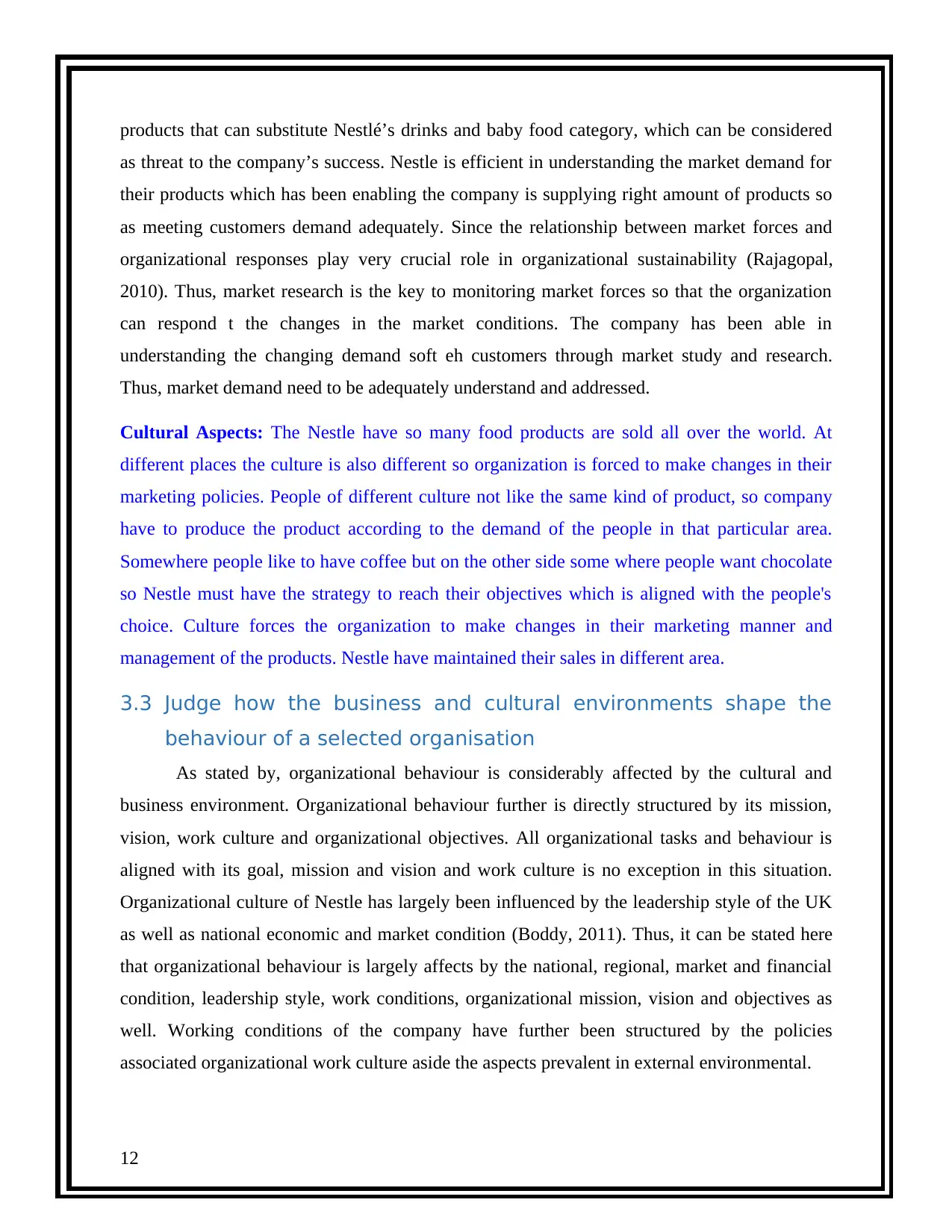
products that can substitute Nestlé’s drinks and baby food category, which can be considered
as threat to the company’s success. Nestle is efficient in understanding the market demand for
their products which has been enabling the company is supplying right amount of products so
as meeting customers demand adequately. Since the relationship between market forces and
organizational responses play very crucial role in organizational sustainability (Rajagopal,
2010). Thus, market research is the key to monitoring market forces so that the organization
can respond t the changes in the market conditions. The company has been able in
understanding the changing demand soft eh customers through market study and research.
Thus, market demand need to be adequately understand and addressed.
Cultural Aspects: The Nestle have so many food products are sold all over the world. At
different places the culture is also different so organization is forced to make changes in their
marketing policies. People of different culture not like the same kind of product, so company
have to produce the product according to the demand of the people in that particular area.
Somewhere people like to have coffee but on the other side some where people want chocolate
so Nestle must have the strategy to reach their objectives which is aligned with the people's
choice. Culture forces the organization to make changes in their marketing manner and
management of the products. Nestle have maintained their sales in different area.
3.3 Judge how the business and cultural environments shape the
behaviour of a selected organisation
As stated by, organizational behaviour is considerably affected by the cultural and
business environment. Organizational behaviour further is directly structured by its mission,
vision, work culture and organizational objectives. All organizational tasks and behaviour is
aligned with its goal, mission and vision and work culture is no exception in this situation.
Organizational culture of Nestle has largely been influenced by the leadership style of the UK
as well as national economic and market condition (Boddy, 2011). Thus, it can be stated here
that organizational behaviour is largely affects by the national, regional, market and financial
condition, leadership style, work conditions, organizational mission, vision and objectives as
well. Working conditions of the company have further been structured by the policies
associated organizational work culture aside the aspects prevalent in external environmental.
12
as threat to the company’s success. Nestle is efficient in understanding the market demand for
their products which has been enabling the company is supplying right amount of products so
as meeting customers demand adequately. Since the relationship between market forces and
organizational responses play very crucial role in organizational sustainability (Rajagopal,
2010). Thus, market research is the key to monitoring market forces so that the organization
can respond t the changes in the market conditions. The company has been able in
understanding the changing demand soft eh customers through market study and research.
Thus, market demand need to be adequately understand and addressed.
Cultural Aspects: The Nestle have so many food products are sold all over the world. At
different places the culture is also different so organization is forced to make changes in their
marketing policies. People of different culture not like the same kind of product, so company
have to produce the product according to the demand of the people in that particular area.
Somewhere people like to have coffee but on the other side some where people want chocolate
so Nestle must have the strategy to reach their objectives which is aligned with the people's
choice. Culture forces the organization to make changes in their marketing manner and
management of the products. Nestle have maintained their sales in different area.
3.3 Judge how the business and cultural environments shape the
behaviour of a selected organisation
As stated by, organizational behaviour is considerably affected by the cultural and
business environment. Organizational behaviour further is directly structured by its mission,
vision, work culture and organizational objectives. All organizational tasks and behaviour is
aligned with its goal, mission and vision and work culture is no exception in this situation.
Organizational culture of Nestle has largely been influenced by the leadership style of the UK
as well as national economic and market condition (Boddy, 2011). Thus, it can be stated here
that organizational behaviour is largely affects by the national, regional, market and financial
condition, leadership style, work conditions, organizational mission, vision and objectives as
well. Working conditions of the company have further been structured by the policies
associated organizational work culture aside the aspects prevalent in external environmental.
12
⊘ This is a preview!⊘
Do you want full access?
Subscribe today to unlock all pages.

Trusted by 1+ million students worldwide
1 out of 16
Related Documents
Your All-in-One AI-Powered Toolkit for Academic Success.
+13062052269
info@desklib.com
Available 24*7 on WhatsApp / Email
![[object Object]](/_next/static/media/star-bottom.7253800d.svg)
Unlock your academic potential
Copyright © 2020–2025 A2Z Services. All Rights Reserved. Developed and managed by ZUCOL.





